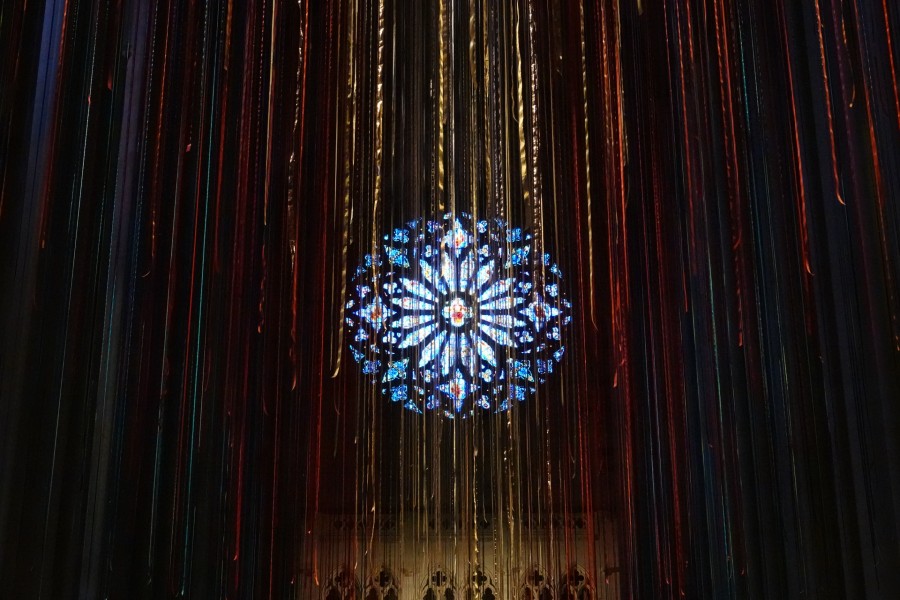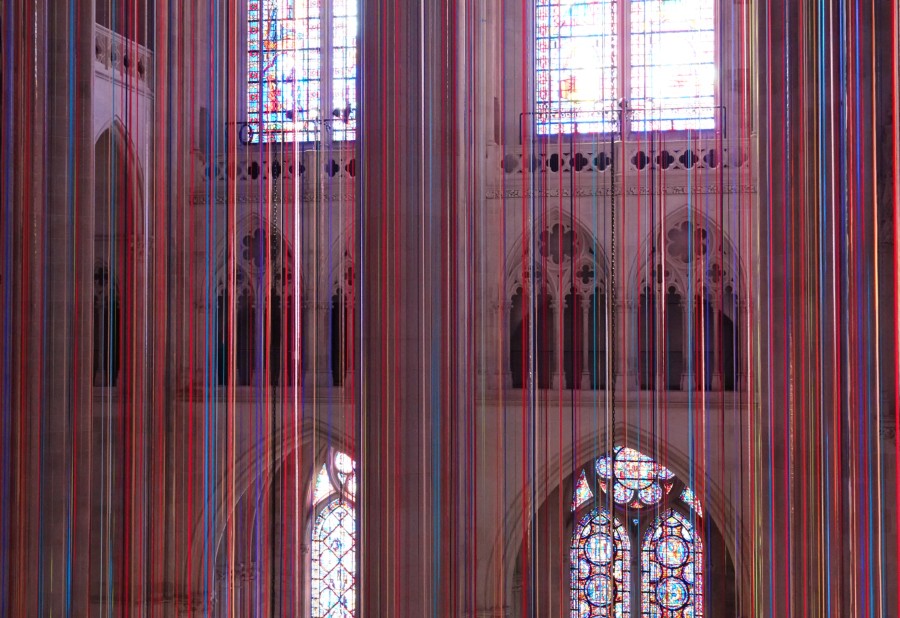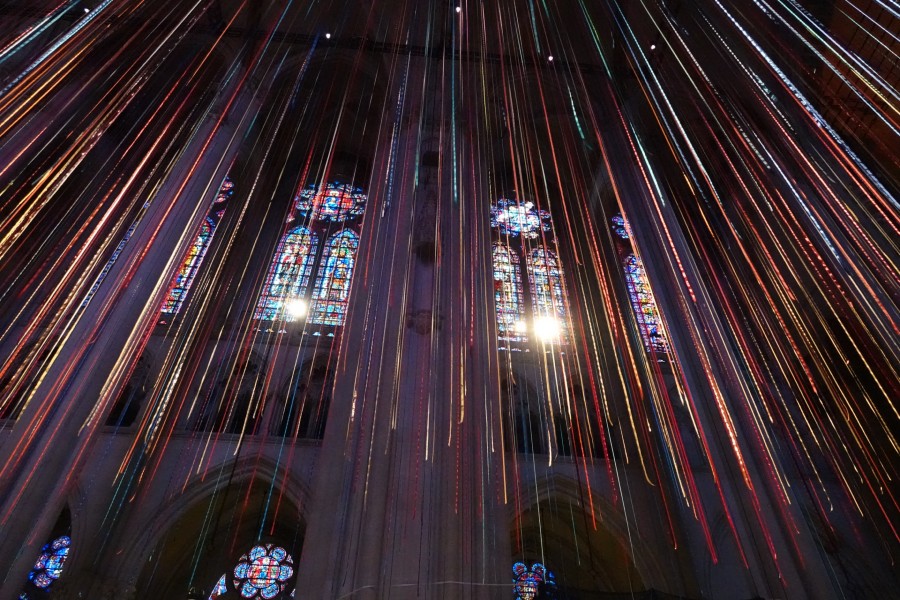
The Cathedral of St. John the Divine in Harlem during the fabrication of Divine Pathways, a new, site-specific monumental installation by artist Anne Patterson.
The work launched on Thursday, October 12, 2023, at the Cathedral of St. John the Divine, 1047 Amsterdam Avenue in Harlem, NY.
Patterson’s largest work to date—an immense field of ribbons— cascades in light and color from the vaulted arches of the Cathedral’s interior, drawing from the hues of stained glass and shadows within the Cathedral’s nave and leading viewers’ eyes to the elegant architectural details throughout the interior, newly revealed after years of restoration and cleaning.
To prepare for installation, Patterson was on-site to oversee the fabrication of over 1,100 lengths of blue, red, and gold fabric. Each ribbon is 75 feet in length (approximately seven stories high), and when combined will be almost 16 miles long (longer than the island of Manhattan). The ribbons are then be hung on a 120’ x 30’ aluminum truss frame and suspended approximately 90 feet above the floor of the Nave of the Cathedral. Steel cables extend through holes in the ceiling all the way up to the Cathedral’s forêt (upper attic space) to support the structure.
Each of the pieces comprising this massive textile installation speaks to the deepest hopes and thoughts of the Cathedral and wider community. Individuals and organizations from across the Morningside Heights neighborhood in Harlem, New York City, and the Episcopal Diocese of New York are invited to literally write themselves into the work by setting down their hopes, dreams, and prayers onto the ribbons themselves.
Throughout the duration of the exhibition, public programs and workshops will offer visitors the opportunity to continue adding their utmost dreams and aspirations to the piece. Individual prayers will be anonymous and beyond the viewer’s sight, but their collective presence will create an experience both intimate and immense, celebrating the collaborative process and community itself.
Here’s the interview with the artist Anne Patterson:
Harlem World Magazine: Who has been an inspiration for your art in your site-specific installation at the Cathedral?
Anne Patterson: The stained glass window “Christ in Glory” was the inspiration for the colors of the piece, specifically, because he has a center, which is gold, and then he has a red robe. And then the surroundings are blue and green. So I recreated that in the color layout of the piece. The other thing that’s been incredibly inspirational to me is the Cathedral at large because it’s probably one of the most beautiful spaces in the world. And the grandeur of it, obviously, is incredibly inspiring… To think that I could even contemplate creating a piece that’s 125 feet by 75 feet by 30 feet!
HWM: Do you have a favorite spot for viewing the installation?
AP: My favorite spot for viewing the installation is right when you first walk in. I think that’s the best spot.
HWM: What does the title of the work Divine Pathways mean?
AP: I visualize the long strips of fabric in this work as pathways. And those pathways are taking the hopes, dreams and prayers on the top of those ribbons and spreading them out to the world at large. And at the same time, those pathways are bringing grace down to us as we stand on the floor of the Cathedral.
HWM: What do you want the piece to accomplish?
AP: I want the piece to accomplish quite a few things. But one big thing is actually the celebration of pure beauty. I think that we are moving farther and farther away from just being able to enjoy, whether it’s a piece of music a piece of literature, or a piece of art, just for the sake of the piece itself. And I think there’s so much power in immersing yourself in pure beauty, and in this case, even just immersing yourself in this depth of these colors. It reminds me a bit of like when you go for a walk in the woods, and you’re just surrounded by trees, and you just take all of that in, and it nourishes you, and restores you.
HWM: Where did you get the concept for the installation? We love the collaborative aspect of the project, where did you get the idea?



AP: This piece originated at Grace Cathedral in San Francisco. We did some of the prayer writing on the top of the ribbons there but was a much smaller involvement of people. And so I felt that that could be a very important part of the peace. And I feel now, especially coming out of COVID, that we are all searching for community and want to feel that we are part of a community. And so that really contributed to the idea of it. And I think also we’re in a very difficult time, as we all know, between global warming and political animosity. And now obviously what’s happening in the Middle East. And so I think being able to provide people a forum or a place where they could actually write down their concerns and also their gratitude. A lot of the prayers were about gratitude. So it was it was a number of different things that came across on those missives.
HWM: How will the work be the installation be on view?
AP: The exhibition was on view from October 12, 2023, through June 2024.
HWM: Someone once said that “art and politics” are like church and state – separate. How do you feel about that?
AP: I don’t really agree with that at all, actually. I feel that my art isn’t very political. But I guess you could say it’s political because I’m including these individual statements and you could see how someone may take umbrage with that. But I totally support political art because I think often it brings to light things that we’re unaware of. And often I think it’s a forum to expose people to things that they may not otherwise get a chance to experience or even a chance to know about. Because I feel it’s a little bit like reaching out a hand to someone and saying, Hey, look at this side of things. Look, have you ever thought of it this way, instead of being like a newscaster hitting them over the head, I think art is a really great way to get information passed along to people. So I believe that politics and art can be separate or they can be together, but I don’t think it’s bad for there to be political art.
HWM: Why did you use material (fabric, steel, etc.,) for the installation?
AP: I use this material because it’s predominantly satin. The ribbons that I purchase for the ribbon section are generally satin on one side and matte on the other. And so when they are caught in the wind currents, they wiggle a little bit and they catch the light in a really beautiful way. The inner ribbons or fabric strands are actually I use this material because it’s predominantly satin. The ribbons that I purchase for the ribbon section are generally satin on one side and mad on the other. And so when they are caught in the wind currents, they wiggle a little bit and they catch the light in a really beautiful way. The inner ribbons or fabric strands are actually a fabric that I purchased and then had laser cut into those thin ribbon-like strips. And those are a variety of fabrics, not just satin, there’s a polyester, there’s a chiffon. And two of the ribbons actually came from Mumbai, India. And those are the ones that are really highly reflective. And I’ve actually never seen a material like that here. I’m sure there must exist somewhere. But they’re ribbons specifically for Indian weddings. And they’re pretty fantastic. And that’s what actually gives the gold that little special pop.
HWM: How is this installation different or similar to your past work?
AP: It’s similar in that it’s the same material; it’s very different in the sense of scale, and the color layout is very different. The density is quite different. Often I do things that are a lot denser. So it really feels like these big swaths of color that are just floating or laying in space. And here, because we’re in this beautiful Cathedral, I wanted there to be more air within it. So I’m providing space for the spirit to be able to move within the piece and actually all the visitors’ own spirits and their own intentions, so they become part of it and it’s not some monolithic piece.
HWM: How can our readers stay in touch with you and see more of your work?
AP: They can follow me on Instagram @annepattersonstudio or my website, https://www.annepatterson.com/.
HWM: Thank you.
Photo credit: 1-3). Cathedral of St. John the Divine.
- Lincoln Theodore Monroe Andrew Perry, “Stepin Fetchit,” The Rise And Fall Of The First Black Super Star, 1902 – 1985
- Sponsored Love: AARP Plan F Benefits, What You Need To Know?
- Discover 5 Reasons Of Class Events Is Perfect For Your Special Day
- Jean Shafiroff Honored At 25th Celebration Of The James Jay Dudley Luce Foundation
- Boston: Smino Honored With Lifetime Achievement Award By Harvard’s Black Men’s Forum
Become a Harlem Insider!
By submitting this form, you are consenting to receive marketing emails from: . You can revoke your consent to receive emails at any time by using the SafeUnsubscribe® link, found at the bottom of every email. Emails are serviced by Constant Contact









